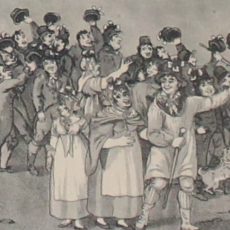
Bath was eighteenth-century England’s most fashionable spa town, teeming with aristocrats, gentry families, middling sort, politicians, and soldiers. The first Pump Room and Assembly Rooms were built during the reign of Anne, while the appointment of Richard ‘Beau’ Nash as Master of Ceremonies in 1705, who implemented a strict social regimen, helped to cement Bath’s status as a popular resort and social hub in addition to a medicinal spa. Between the 1720s and 1770s, father and son John Wood the Elder and Younger designed and built Queen Square, The Circus, and the Royal Crescent, along with new Assembly Rooms – all in the elegant Palladian style. As the century progressed, the city’s population expanded rapidly from 3,000 to 35,000. By 1820, however, it had arguably fallen behind the likes of Brighton and Cheltenham as England’s premier pleasure resort.
Although Bath’s electorate was restricted to the thirty members of the corporation, it has been described by the History of Parliament as an ‘outstandingly independent and respectable borough’ and ‘a model borough’. The corporation was said to have been proudly independent of government or patron influence, and elections were resolved without bribery or reference to personal interests. Local politics were dominated by civic leaders and local gentry (drawn from the neighbouring counties of Somerset, Gloucestershire, and Wiltshire). For much of the eighteenth century, the corporation favoured local gentlemen and citizens or prominent national politicians (from Sir John Ligonier to William Pitt the Elder) as their MPs. Elections were frequently decided well in advance of the poll, but even in an uncontested general election voters could demonstrate partisanship by choosing to use only one of their votes. From 1790, the Pratts (Earls of Camden) and Thynnes (Marquesses of Bath) could sometimes nominate Members, provided they could procure adequate patronage for the corporation.
Polling for parliamentary elections took place at a special meeting of the Council at the Guildhall. Votes were sometimes recorded on separate voting papers, before being entered into the corporation minute books. Prior to 1708, the procedure for electing MPs mirrored Bath’s municipal elections. Each seat was polled separately. If more than two candidates appeared, a first round of voting would eliminate all but the two candidates with the most votes, who would then enter a second round of voting to determine who won the seat. This opened the possibility of the losing candidates in either round to put their name forward for the other seat.






